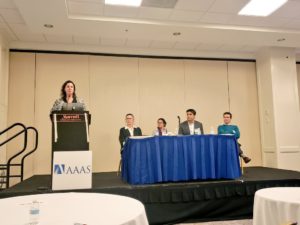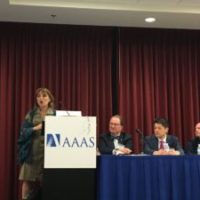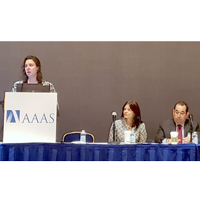CCC@AAAS2019 – Sustainably Feeding Ten Billion People

The Sustainably Feeding Ten Billion People panel: (from left to right) Ann Drobnis, Susan McCouch, Diane Wang, Ranveer Chandra, and Abraham Stroock
How can we feed the world’s population – projected to reach ten billion people by 2050 – in a sustainable way that preserves the health of individuals, communities, and the environment? How can computer science be utilized to improve food production, processing, and distribution? These were the main topics at the Computing Community Consortium’s (CCC) scientific session on Sustainably Feeding Ten Billion People that took place February 16th at the AAAS 2019 Annual Meeting.
The panelists for this session were Diane Wang (SUNY Buffalo), Ranveer Chandra (Microsoft Research), and Abraham Stroock (Cornell), while Susan McCouch (Cornell) moderated the session.
Diane Wang’s presentation on Coupling Nature and Nurture: Supercharging Predictions for Agricultural Crops provided an overview of the history of human agriculture, starting with early crop domestication up to the Green Revolution of the 1960s to marker assisted selection of the 2000s, setting the stage to explain the major impact that selective breeding has had on our ability to increase agricultural yields. Wang’s current work uses computer simulation modeling that combines genetic information with knowledge of plant response to environmental stress in order to improve predictions of crop performance. The long-term goal of this work is to augment visual and marker-assisted selection with a new selection tool to help breeders to make decisions under novel environments.
In Bridging the Digital Divide: Cloud Computing with Smart Sensors for Farms, Ranveer Chandra discussed his work with Microsoft Research’s FarmBeats project. Farmbeats provides farmers with access to sensors, cloud computing, and machine learning algorithms to enable data-driven decision-making. Chandra’s projects relied on creating end to end solutions to the problems of data collection for rural farmers; for instance, since farmers typically have poor access to internet connections he used the white spaces that exist in unused TV channels to increase connectivity and access to the cloud. In areas where drones where too expensive, constrained by regulations, or were too power constrained his team created “Tethered Eyes” – cell phones tied to balloons. Tethered eyes are relatively cheap and have a long (4-7 day) lifetime, which improves the ability of farmers to monitor their fields.
Finally, Abraham Stroock spotlighted the need for greater research on the biomechanics of plants in Measuring the Pulse of Plants: Biomimetic Nanotechnologies. While there is clearly tons of biomedical research into humans and other animals, Stroock called plants “the forgotten eukaryotes” – no tool comparable to a hypodermic syringe, a basic medical tool to insert or expel fluids in animals, exists for plants. Stroock’s presentation detailed his research project to build synthetic plants that can interface with real plants to determine the water pressure within the stem and monitor other related traits. This work aims to improve water management in farms by monitoring the dynamics in real plants, turning the organism into a sensor.
During the Q&A a number of participants asked about the issues of cybersecurity and data management related to these projects. Chandra spoke not only to the need to ensure that data is not compromised during collection/storage, but also to the necessity of verifying that the data has not been changed or corrupted before being deployed. Susan McCouch referenced several different models for data management and usage, including Farmobile that pays farmers a flat rate for data or farmer co-ops that pool data together to sell it as a coalition.
For more information see the CCC@AAAS webpage.









